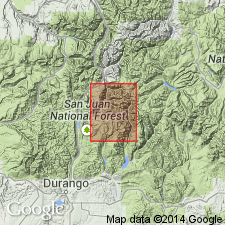
- Usage in publication:
-
- Uncompahgre formation*
- Modifications:
-
- Revised
- AAPG geologic province:
-
- Southern Rocky Mountain region
Summary:
Uncompahgre formation in this quadrangle overlies a conglomerate here named Vallecito conglomerate. These 2 formation are here united into a group called Needle Mountains group. [Age is pre-Cambrian.]
Source: US geologic names lexicon (USGS Bull. 896, p. 2213-2214).

- Usage in publication:
-
- Uncompahgre formation*
- Modifications:
-
- Original reference
- Dominant lithology:
-
- Quartzite
- AAPG geologic province:
-
- Southern Rocky Mountain region
Summary:
Uncompahgre formation. A complex of massive white or smoky quartzites and dark slates, with a few members in which those rocks alternated in thinner layers. Thickness 8,000+ feet. No fossils, but considered to be of Algonkian age. Unconformably underlies Ignacio
quartzite (Cambrian) and unconformably overlies schist and gneiss of probable Archean age.
Well exposed in Uncompahgre Canyon, Silverton and Ouray 15-min quadrangles, [Ouray Co.] southwestern CO.
Source: US geologic names lexicon (USGS Bull. 896, p. 2213-2214).

- Usage in publication:
-
- Uncompahgre formation*
- Modifications:
-
- Age modified
- AAPG geologic province:
-
- Southern Rocky Mountain region
Summary:
Uncompahgre formation of Needle Mountains group. For many years this formation was classified as "Algonkian," but the terms "Algonkian system" and "Archean system" having been discarded by the USGS the formation is now classified as pre-Cambrian.
Recognized in southwestern CO.
Source: US geologic names lexicon (USGS Bull. 896, p. 2213-2214).
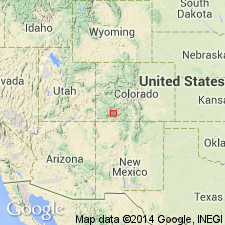
- Usage in publication:
-
- Uncompahgre Formation*
- Modifications:
-
- Overview
- AAPG geologic province:
-
- Southern Rocky Mountain region
Summary:
Exposed in Needle Mountains in an arc about 22 mi long from Lime Creek on the west to area north of Emerald Lake, La Plata and San Juan Cos, CO in the Southern Rocky Mountain region. Unconformably overlies older rocks. Geologic sketch map. Shown in explanation for sketch map as younger than the Tenmile and Bakers Bridge Granites and older than the quartz diorite of Pine River. Is mostly quartzite, slate, phyllite, and schist; siltstone and conglomerate present in minor amounts. Locally has a basal conglomerate 1 1/2 to 8 ft thick of jasper and chert in a quartzose matrix. Estimated as 12,985 ft thick. Had the same source as the Vallecito Conglomerate. Of Precambrian age. Detailed lithologic description.
Source: GNU records (USGS DDS-6; Denver GNULEX).
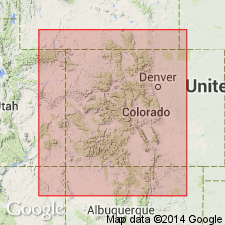
- Usage in publication:
-
- Uncompahgre Formation*
- Modifications:
-
- Overview
- AAPG geologic province:
-
- Southern Rocky Mountain region
Summary:
Removed from Needle Mountains Group (abandoned). Is younger than granites of circa 1,700 m.y. age group and older than granites of circa 1,400 m.y. age group; assigned to Precambrian Y and X. [Name used in southwest CO in the Southern Rocky Mountain region.]
Source: GNU records (USGS DDS-6; Denver GNULEX).
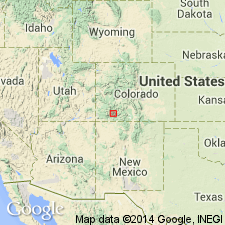
- Usage in publication:
-
- Uncompahgre Formation
- Modifications:
-
- Revised
- AAPG geologic province:
-
- Southern Rocky Mountain region
Summary:
Is an allochthonous sequence deposited before 1,640 m.y. and deformed before 1,430 m.y., the age of the Eolus Granite batholith. Its relation to the Vallecito Conglomerate is uncertain; neither has been dated radiometrically, and no common contact exists between them. The Twilight and Irving, both older than Uncompahgre, were deformed about 1,760. The Uncompahgre-Irving contact considered to be a thrust. Contact of Uncompahgre with Vallecito and with Tenmile Granite considered to be a thrust. Is not thought to be a unique and isolated remnant of supra-crustal rocks deposited on a deeply eroded basement. New relationship shown on Figure 1.
Source: GNU records (USGS DDS-6; Denver GNULEX).
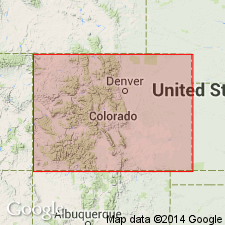
- Usage in publication:
-
- Uncompahgre Formation*
- Modifications:
-
- Overview
- AAPG geologic province:
-
- Southern Rocky Mountain region
Summary:
Composed of thick light-colored quartzite and pyritic black slate and phyllite, about 2,650 m (8,700 ft) at type. Unconformable on gneisses of Irving and Twilight Formations. Cut by Eolus Granite. Age bracketed between 1,440 and 1,695 m.y., or Early and Middle Proterozoic. Is cut by Eolus Granite of 1,440 m.y. Principally exposed in Needle Mountains and in scattered localities in western San Juan Mountains. Known in subsurface in three areas; inferred to extend near to NM border into Piedra River. These areas are in the Southern Rocky Mountain region. Unconformably overlies Irving and Twilight Formations. Is probably equivalent to Vallecito Conglomerate. Its source area was to the north. Vallecito and Uncompahgre are both considered to Early and Middle Proterozoic.
Source: GNU records (USGS DDS-6; Denver GNULEX).
For more information, please contact Nancy Stamm, Geologic Names Committee Secretary.
Asterisk (*) indicates published by U.S. Geological Survey authors.
"No current usage" (†) implies that a name has been abandoned or has fallen into disuse. Former usage and, if known, replacement name given in parentheses ( ).
Slash (/) indicates name conflicts with nomenclatural guidelines (CSN, 1933; ACSN, 1961, 1970; NACSN, 1983, 2005, 2021). May be explained within brackets ([ ]).

